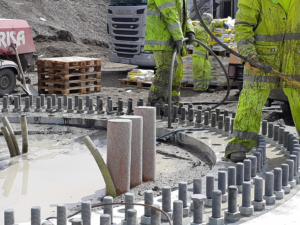Reliable Rock Anchors for Secure and Stable Foundations
In the world of civil engineering, the function of reputable rock anchors can not be overemphasized, as they are pivotal in establishing protected and steady structures across a variety of applications. Recognizing the different kinds of rock anchors, their specific applications, and the ins and outs of installment and maintenance is necessary for optimizing their efficiency.
Kinds Of Rock Anchors

Passive anchors count on the weight of the framework and the bordering dirt or rock to supply resistance. They are typically made use of in applications where marginal movement is expected. Energetic supports, on the various other hand, include the application of stress via a high-strength cord or pole, creating a pre-stressed problem in the support. This type is particularly useful in dynamic atmospheres, such as landslide-prone locations.
Grouted supports are an additional substantial group, wherein a steel bar or cable is inserted right into a drilled opening, adhered to by a cementitious grout. As soon as cured, the grout bonds with the surrounding rock, creating a robust anchoring system. Each sort of rock support provides distinctive benefits based upon the particular geological conditions and architectural requirements, consequently playing an essential duty in the general integrity and long life of constructed facilities.
Applications in Construction
Rock anchors play a pivotal duty in different building applications, giving essential assistance and stability in varied environments. These cutting-edge options are used in tasks ranging from large-scale framework developments to smaller property structures. Among the primary applications of rock supports is in the stabilization of slopes and retaining walls, where they assist stop dirt disintegration and keep structural stability.
Additionally, rock supports are critical in securing foundations for bridges, passages, and skyscrapers, ensuring they can endure side pressures such as wind and seismic activity. Their flexibility enables installment in difficult geological problems, making them suitable for tasks in hilly or rough surfaces.

Key Selection Criteria
Picking the proper rock support for a particular application calls for careful consideration of several vital criteria. The geological conditions of the site must be thoroughly assessed. Comprehending rock type, strength, and security is necessary to make certain that the anchor will perform effectively under lots conditions.

One more crucial factor is the rust resistance of the anchor materials. In click here for more atmospheres subjected to dampness or chemicals, making use of corrosion-resistant materials will lengthen the life-span of the anchors and preserve architectural integrity in time.
In addition, the support's installation approach ought to align with the task's needs and constraints. Ease of installment, in addition to the potential effect on bordering frameworks, should be taken into consideration.
Installment Strategies
Effective installation strategies are important for the successful efficiency of rock supports. Proper setup ensures that the supports attain the desired load-bearing capacity and stability within the geological conditions. The initial step in the setup process involves site evaluation, where geological studies identify the rock type, condition, and any kind of potential challenges.
Once the website is examined, the appropriate exploration approach need to be chosen-- options include rotary exploration, diamond drilling, or percussion boring. The selection depends upon rock hardness and ecological considerations. Exact drilling deepness and angle are necessary to make sure that the supports align with structural demands and load distribution.
After exploration, the next phase includes cleaning up the borehole to remove debris, which can compromise bond strength. Following this, the anchor is placed, and if needed, a cement or material is infused to enhance attachment. The healing time of these materials must be stuck to, guaranteeing that the supports accomplish complete toughness before any type of tons is used.
Upkeep and Evaluation
Proper upkeep and examination of rock anchors are vital to ensure their lasting performance and dependability (Williams Anchors). Normal analyses aid recognize any kind of possible problems, such as deterioration, displacement, or structural tiredness that might jeopardize the stability of the anchoring system
Routine assessments ought to be carried out at published here defined periods, thinking about ecological variables and the specific application of the rock anchors. Aesthetic examinations need to concentrate on the subjected sections of the supports, inspecting for indications of rust, splits, or other anomalies. Additionally, it is crucial to evaluate the surrounding geological problems to find any you could try this out type of shifts in soil or rock that might impact anchor efficiency.
Sometimes, more sophisticated techniques such as tons screening or non-destructive testing might be required to ascertain the anchors' load-bearing capability and general health and wellness. Correct paperwork of assessment searchings for, maintenance activities, and any kind of repair work or substitutes done is vital for continuous evaluation and compliance with industry criteria.
Final Thought
To conclude, trustworthy rock supports play a vital duty in guaranteeing safe and secure and secure foundations throughout different construction applications. By properly moving tons and boosting security versus side pressures, these anchors add dramatically to the longevity and integrity of structures such as bridges, tunnels, and keeping walls. Strategic selection, setup, and upkeep of rock anchors are crucial for enhancing efficiency and protecting public security, inevitably emphasizing their relevance in modern-day design techniques.